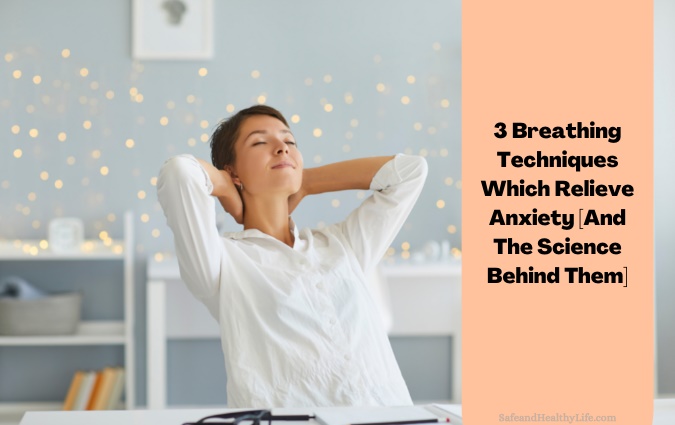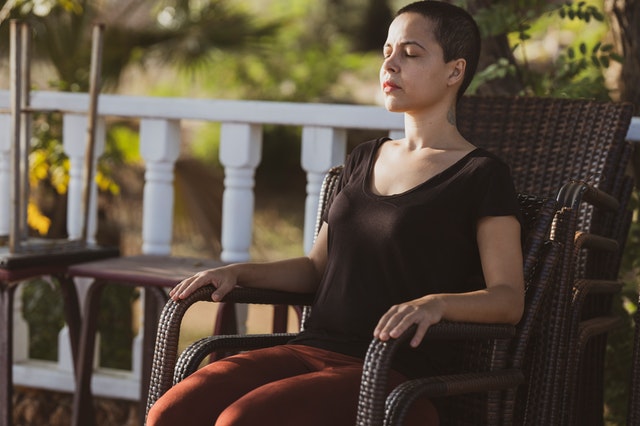3 Breathing Techniques Which Relieve Anxiety [And The Science Behind Them]

We become anxious when we worry about the future. Anxiety sufferers know that it affects emotions and causes physical stress and even pain.
The number of people suffering from Anxiety has grown in recent years due to the effects of Covid-19 and the pandemic. The good news is that Anxiety is possible to manage, and the methods are free and accessible to everyone.
In this post, you will read about three breathing techniques that relieve Anxiety. You will also learn about the science behind these techniques and why they work.
I hope you become inspired to try these breathing techniques for yourself and learn some free tools to manage Anxiety in the process.
The Anxious Body
If you suffer from anxiety then you will recognize some of these symptoms.
- Restlessness or tension
- Tightness in the chest
- Fast breathing
- Heart palpitations
- Excess sweat
- Emotions; fear, worry, foreboding
Experiencing these symptoms, sometimes all at once, can be overwhelming and may feel impossible to manage. However, all of these symptoms result from the same issue, an imbalance in the nervous system.
They are all a response to the flight, fight, freeze response which is the body’s way of responding to threats.
A potential threat releases cortisol which triggers the fight, flight, freeze response. And the body gets ready to react.
But what happens if there is no immediate danger, and instead of calming down and recovering, the body releases more cortisol. This is when Anxiety can take over life and make day-to-day living very difficult.
The breathing techniques below help the body to rebalance. Each technique works slightly differently and is a powerful way to manage Anxiety.
Three breathing techniques that relieve Anxiety
There are countless breathing techniques out there that can help with anxiety. I’ve included the three techniques which I have found to be most useful in my own practice. These techniques have also been studied and found to be effective at reducing anxiety levels.
If you want to practice any of these techniques there are countless videos and tutorials online which will guide you through the practices.
Below I have included step-by-step instructions for each practice so that you can get started.
Resonance Breathing
Resonance breathing is also known as coherent breathing. This is a method of slowing down the breath to calm the body and rebalance the nervous system. This type of breathing improves your HRV which is a good indicator of how well your nervous system responds to stress.

Photo Credit: Pexels
As we slow the breath down the body begins to feel calmer and switches to operating from the rest and digest system.
The natural breath cycle is around 2 – 3 seconds for one cycle of breath. During coherent breathing, one cycle of breath is extended to around 6 seconds.
The breath is linked to the autonomic nervous system, which is made up of the sympathetic and parasympathetic nervous systems.
Slowing down the breath signals to the autonomic nervous system that the body is not being threatened. Once this signal has been recognized the body will shift into using the parasympathetic nervous system instead of the sympathetic nervous system.
The parasympathetic nervous system is also known as rest and digest. The whole body will calm down in line with the slowing of breath.
Diaphragmatic breathing
The diaphragm is a large muscle that controls the inhalation and exhalation of the lungs. Diaphragmatic breathing places attention on this muscle so that more air is taken into the lungs. Most of us do not breathe correctly, our breathing rate is too fast and the Oxygen we take in sits at the top of the chest.
During diaphragmatic breathing more oxygen is taken in on the inhale. The breath fills the whole lung cavity to the point where the chest and the belly will rise.
The effects of this type of breathing are the same as resonance breathing, the breath is slowed down which tells the body to switch over to the parasympathetic nervous system, the rest and digest system.
Mindful Breathing
Mindful breathing teaches the student to pay attention to the present moment without judgment. Mindful breathing helps students to accept their present moment experience, even if it is not comfortable.

Photo Credit: Pexels
This is a useful technique for people who suffer from anxiety since there are many symptoms. Through the practice of Mindful breathing, students learn that whatever symptoms they are experiencing in the present moment is ok. They also learn to have compassion for themselves and their experience too.
Mindful breathing can be practiced as a stand-alone technique or alongside any of the other breathing practices.
To practice, set an intention of connecting with the breath and the present moment. If thoughts begin to arise, notice those thoughts without judgment and guide the attention back to the breath. Practice with the intention of self-compassion and care for oneself.
Conclusion
All three of these techniques are incredibly effective at treating Anxiety. I encourage you to give them a try, go gently and ease yourself into them. Be mindful of what is and isn’t working for you.
If you experience panic attacks or very severe generalized anxiety you might find that breathing practices are not accessible to you at this time. If this is the case you could try mindful movement, a body scan, or a mindful walking practice.
There are many techniques to try and so many easy ways to add breathing practice into your weekly routine. Whether it’s through a class, a course, an app, a music track, or simply self-guided.
Even if the symptoms appear too much to handle sometimes, Anxiety can be managed and cured.
About The Author:
Cheryl A Clarke – Accredited Mindfulness Meditation Teacher, Psychology Student, and Content Writer for harmonicbreathing.com, a completely free-to-use breathing technique to reduce anxiety and improve sleep, with over 4,000 monthly active users.

